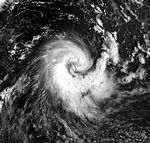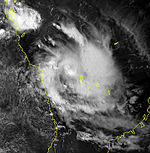- 1995–96 Southern Hemisphere tropical cyclone season
-
The 1995-96 Southern Hemisphere tropical cyclone season ran throughout the year from 1 July 1995 to 30 June 1996. It was made up of three different basins and seasons; the
- 1995–96 South-West Indian Ocean cyclone season west of 90°E, discussed in this article
- 1995–96 Australian region cyclone season between 90°E and 160°E
- 1995–96 South Pacific cyclone season east of 160°E
South-West Indian Ocean
Intense Tropical Cyclone Daryl-Agnielle
Intense tropical cyclone (MFR) Category 5 tropical cyclone (SSHS) 
Duration November 17 – November 23 Intensity 175 km/h (110 mph) (10-min), 925 mbar (hPa) Intense Tropical Cyclone Bonita
Intense tropical cyclone (MFR) Category 4 tropical cyclone (SSHS) 

Duration January 3 – January 15 Intensity 195 km/h (120 mph) (10-min), 920 mbar (hPa) Tropical Cyclone Bonita struck Madagascar and then the east coast of Mozambique. 11 people were killed in Mozambique. [1]
Tropical Depression B2
Tropical depression (MFR) 
Duration December 28 – December 31 Intensity 55 km/h (35 mph) (10-min), 995 mbar (hPa) Severe Tropical Storm Hubert-Coryna
Severe tropical storm (MFR) Category 1 tropical cyclone (SSHS) 

Duration January 9 – January 12 Intensity 115 km/h (70 mph) (10-min), 965 mbar (hPa) Severe Tropical Storm Doloresse
Severe tropical storm (MFR) Category 1 tropical cyclone (SSHS) 

Duration February 12 – February 20 Intensity 95 km/h (60 mph) (10-min), 977 mbar (hPa) Tropical Cyclone Edwige
Tropical cyclone (MFR) Category 2 tropical cyclone (SSHS) 
Duration February 21 – February 29 Intensity 150 km/h (90 mph) (10-min), 945 mbar (hPa) Tropical Cyclone Flossy
Tropical cyclone (MFR) Category 4 tropical cyclone (SSHS) 
Duration February 26 – March 5 Intensity 150 km/h (90 mph) (10-min), 945 mbar (hPa) Moderate Tropical Storm Guylianne
Moderate tropical storm (MFR) Tropical storm (SSHS) 
Duration March 17 – March 25 Intensity 65 km/h (40 mph) (10-min), 992 mbar (hPa) Tropical Cyclone Hansella
Tropical cyclone (MFR) Category 2 tropical cyclone (SSHS) 
Duration April 2 – April 10 Intensity 120 km/h (75 mph) (10-min), 962 mbar (hPa) Intense Tropical Cyclone Itelle
Intense tropical cyclone (MFR) Category 5 tropical cyclone (SSHS) 
Duration April 6 – April 19 Intensity 175 km/h (110 mph) (10-min), 925 mbar (hPa) Moderate Tropical Storm Jenna
Moderate tropical storm (MFR) Tropical storm (SSHS) 
Duration May 1 – May 6 Intensity 85 km/h (50 mph) (10-min), 984 mbar (hPa) On May 1, the last tropical disturbance of the season formed near the border between the Australian region.[1] It slowly organized and strengthened into a tropical depression early on May 3.[1]
See also
References
- ^ a b "RSMC La Reunion MTS Jenna Best Track". RSMC La Reunion. http://www.meteo.fr/temps/domtom/La_Reunion/base_cyclone/nom_annee/JENNA_1995.html. Retrieved 2009-02-15.
External links
Categories:- Hurricane articles without infoboxes
- Southern Hemisphere tropical cyclone seasons
- 1995–96 Southern Hemisphere tropical cyclone season
Wikimedia Foundation. 2010.
